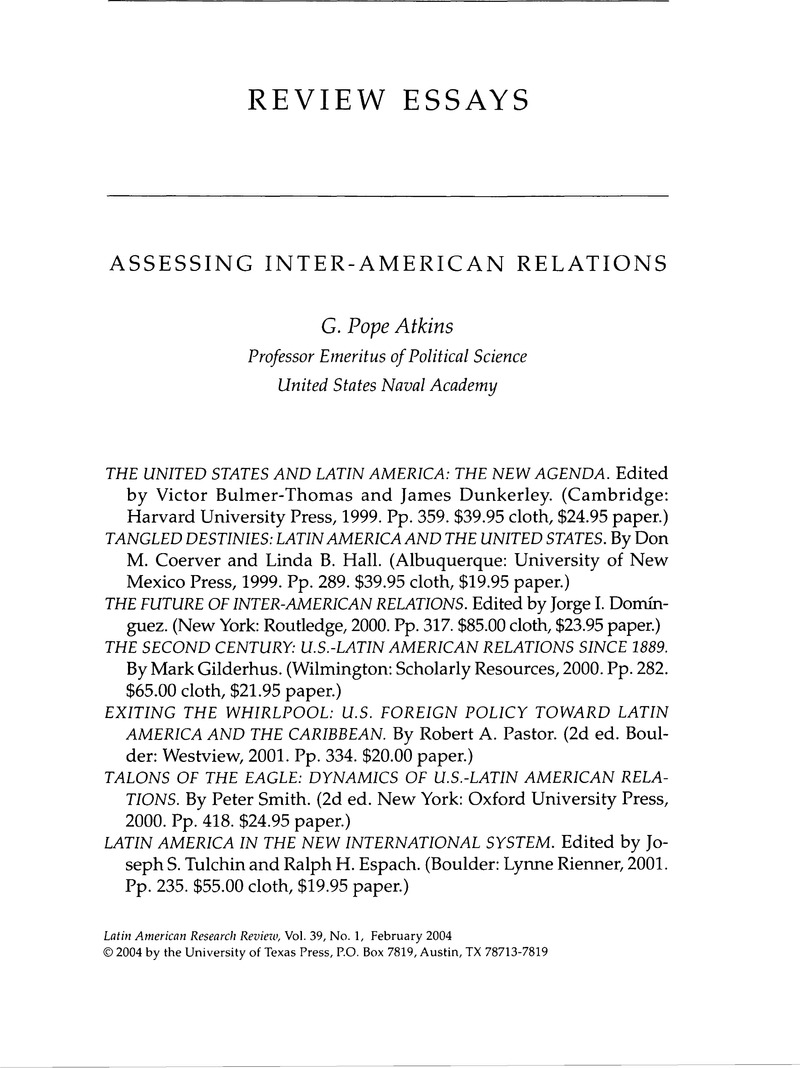Published online by Cambridge University Press: 05 October 2022

1. All of the books examined here were written prior to the inauguration of the Bush presidency in January 2001, with its own foreign policy perceptions and orientations, and the terrorist attacks in the United States on September 11, 2001, which acutely influenced global and inter-American relations. These events especially affect our reading of the authors' identification of current trends and choice of policy prescriptions, which were predicated on conditions observed prior to the new or unanticipated turns of events.
2. Other recent books are of interest to students of inter-American relations: Michael LaRosa and Frank O. Mora, eds., Neighborly Adversaries: Readings in U.S.-Latin American Relations (Lanhan, Md.: Rowman & Littlefield Publishers, 1999), a well-conceived collection of twenty-five documents organized by historical periods designed for use in a college course; Thomas M. Leonard, ed., United States-Latin American Relations, 1850–1903: Establishing a Relationship (Tuscaloosa: University of Alabama Press, 1999), a comprehensive survey of balanced analyses of U.S. relations with thirteen Latin American states; Gordon Mace and Louis Bélanger, eds., The Americas in Transition: The Contours of Regionalism (Boulder, Colo.: Lynne Rienner Publishers, 1999), an examination of general post-Cold War concepts of regionalism and the formal inter-American regional and subregional institutions and the policy strategies of their member states; and David S. Sheinin, ed., Beyond the Ideal: Pan-Americanism in Inter-American Affairs (Westport, Conn.: Greenwood Press, 2000), a compilation of thought-provoking and mostly revisionist treatments of a broad range of thematic, institutional, and individual personality considerations.
3. The above (and other) statements imply tacit recognition of the limits of the realist paradigm to effectively encompass important inter-American phenomena and to facilitate the author's multidisciplinary approach. By extension (and this is my own personal statement) they indicate the necessity for a broader pluralist model of the international system and foreign policymaking for an accurate analysis of essential inter-American phenomena, to include state policymaking with reference to them. It would be utterly foolish to deny the realities of interstate relationships, as it is unrealistic to assert that they are the sum and substance of international relations of any importance and to deny or devalue the criticality of strong and sometimes autonomous transnational phenomena throughout the history of inter-American relations. What is required is recognition of a combined interstate-transnational “international” system, as well as of the importance of internal political and psychological elements of foreign policy analysis. I have explored these matters in Atkins, Latin America and the Caribbean in the International System, 4th ed. (Boulder: Westview Press, 1999), chapter 1; and Atkins, Handbook of Research on the International Relations of Latin America and the Caribbean (Boulder: Westview Press, 2001), 16–23, 28–33.
4. See also Jorge I. Domínguez, ed., International Security and Democracy: Latin America and the Caribbean in the Post-Cold War Era (Pittsburgh: University of Pittsburgh Press, 1998), for an examination of inter-Latin American relations in terms of the characteristics of the new era, the use of international force, and changing security relations.
5. Robert Pastor and Peter Smith, in their respective books under review, represent sharply diverging views on a number of matters. They carry on something of a “footnote war” about the consequences of U.S. power. Pastor directly contrasts his position that Latin Americans possess their own policy recourse to Smith's judgment that “a study of inter-American relations requires only a ‘meditation on the character and conduct of the United States’ and how it has exercised 'its perennial predominance'”; he suggests that the title of Smith's book, Talons of the Eagle, unfairly “evokes a rapacious and unforgiving America” (x). Smith criticizes Pastor on the same subject: Because the internal dynamics in inter-American relations result from the “pervasive and persistent reality” of the character and extent of the asymmetry of state power, “it seems wholly implausible to depict U.S. involvement in the region as the result of suction into a 'whirlpool', as one leading authority has done” (5) Smith cites Pastor's Whirlpool, 1 ed.). They also disagree, more indirectly, about policy advising. Smith sees futility in making recommendations to U.S. policymakers: “My experience is that advice of this sort tends to fall on deaf ears … and that it has a notoriously brief shelf life”; he settles for suggesting “alternative scenarios for eventual relationships between the United States and Latin America” (8). Pastor's purpose, in contrast, is above all to put forward advice to U.S. decision makers: “My style in this book is to integrate the perspective of the policymaker with the eye of the scholar … I am not interested in formulating an abstract theory that provides few lessons for the real world” (xv). On the paradigmatic level, Pastor's intrasocietal policymaking model is the polar opposite of Smith's international systemic structuralist approach. Finally, Pastor deals overwhelmingly with transnational phenomena; Smith emphasizes interstate occurrences and subordinates transnational phenomena to interstate concerns.
6. Pastor cites as the developers of this concept Robert Keohane and Joseph S. Nye, Power and Interdependence: World Politics in Transition (Boston: Little, Brown, and Co., 1977). Keohane and Nye were early leaders advocating a pluralist perspective of the international system, challenging the limitations of the dominant realist state-centric model, and advocating inclusion of transnational phenomena to produce one of a multicentric system of “complex interdependence.”
7. Of related interest is Albert Fishlow and James Jones, eds., The United States and the Americas: A Twenty-First Century View (New York: W.W. Norton, 1999), an explicit and sophisticated exercise in forecasting for policy prescriptive purposes, with reference to U.S. interests in inter-American relations, it contains eight background readings for participants at the 94 American Assembly at Columbia University in May 1998.